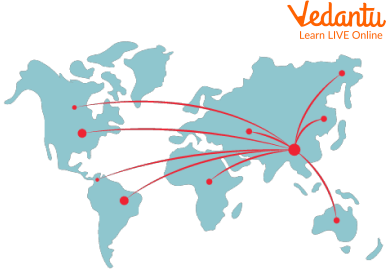




An Overview of Human Migration
Human civilisation is one of the most interesting aspects of the school’s history textbooks. The stories of ancient humans and their migration and evolution never fail to amaze the history aspirants. Over the last few decades, with the help of many types of research and theories, historians have figured out a lot about early human migration.
In this article, we will try to cover as much as possible about migration for kids, and their circumstances. We will also learn why and how did early humans migrate. No single story or research text can cover such an immense period and area in ancient history. We will attempt to understand more about their migration and why did early humans migrate, which took place hundreds of centuries ago.
Human Migrations Timeline
Over the last few decades, there has been a lot of research and discoveries in the field of ancient human fossils. This has led to the rise of multiple theories about migration for kids and its timelines.
Early human migration was the movement of our ancestors in prehistoric times, from one place to other in search of the adequate climatic conditions and resources required to survive their lives. According to most of the theories, the earliest humans are believed to be developed out of australopithecine ancestors. This happened about 3 million years ago in the regions of Eastern Africa.
Reason for Early Human Migration
There can be multiple reasons for the migration of the human race. It is said the development of language happened somewhere around 50,000 years ago. This helped humans to communicate among themselves and allowed them to find solutions to their problems. With this evolved ability to think and speak, humans began looking for solutions to the needs around them, which led to their migration.

Early Human Migration
Although no one can confirm the exact reason for their migration from the African continent, most studies and researches tell that it was due to the depletion of resources in the continent. The most important reason must be the lack of water resources as an average human needs around 2-3 litres per day to survive well. Humans began to think and assess their situation and act upon the required deeds. When they would understand that they are out of any resources, they would migrate and colonize other areas of the continents where the resources were available.
Early Human Migration Routes
We learned that the earliest race of humans originated on the African continent. The earliest fossils of recognizable Homo sapiens that were found through many types of research in Ethiopia trace back to approximately 200,000 years old. It is believed that after leaving the African continent, humans followed the coasts where abundant resources were available.
The first wave of migration occurred somewhere between 90 thousand and 30 thousand years ago. This wave moved across the Middle East's areas, into Southern Asia's regions, and down to the Australian continent. Some thousand years later, additional waves of migration followed. Between 40,000 and 12,000 years ago, our ancestors migrated towards the north into Europe. The icy conditions in the northern belt at the time helped expand early humanity's territory.
Other sources suggest that about 15,000 years ago, North American migration began. Over the next few thousand years, humans eventually spread into South America and pushed into the eastern regions, which are now the eastern United States and Canada.

Migration Routes on the World Map
How did Early Humans Migrate?
Due to the lack of availability of resources, the population used to rise and fall very often. Africa has a wide range of environments, including deserts, lakes, rivers, and mountains. To find the resources they need, such as food, water, and shelter, humans used to go out in small subsets to look out for solutions to their needs. Often these groups used to spread, leaving the original groups. Sometimes they used to return and rejoin their groups and migrate along. In this manner, humans spread across the globe and colonised different parts of different continents.
Summary
Now, we know that humans are the only species on this planet who have successfully populated and adapted to various land regions across the Earth. In this article, we learned how the first modern humans, called Homo Sapiens, migrated to different areas of the world.
Our ancestors began their migration from Africa around 70 to 100 thousand years ago and spread to all corners of the Earth while exploring. This spread of humanity, driven by the necessity of adequate climatic conditions and food resources, facilitated global expansion over the centuries.
FAQs on Early Human Migration
1. What is meant by early human migration?
Early human migration refers to the movement of the first modern humans, Homo sapiens, from their origins in Africa to populate different parts of the world. This was not a single journey but a gradual expansion that took place over tens of thousands of years, as groups moved in search of resources and new territories.
2. What were the main reasons that caused early humans to migrate?
Early humans were primarily hunter-gatherers and moved for survival. The main reasons for their migration include:
- Search for Food: They followed herds of animals and moved to find new sources of edible plants and fresh water.
- Climate Change: Changes in climate, such as droughts or ice ages, made their original homes unlivable, forcing them to find more suitable environments.
- Resource Depletion: Using up all the local resources in one area would prompt them to move to a new, resource-rich location.
- Population Growth: As small groups grew in size, they would split up and expand into new territories to avoid competition.
3. When did the first major human migration out of Africa happen?
While there were earlier migrations by other human-like species, the most significant migration of our species, Homo sapiens, out of Africa is believed to have started around 60,000 to 70,000 years ago. This wave of migration eventually led to the peopling of all the continents.
4. How do scientists know about the routes of early human migration?
Scientists use two main types of evidence to trace the paths of early human migration:
- Archaeological Evidence: This includes discovering and dating human fossils, stone tools, and other artefacts left behind by early humans. The location of these findings helps map their presence across the globe.
- Genetic Evidence: By studying the DNA of modern populations worldwide, scientists can trace genetic markers back through generations to identify common ancestors and map the historical spread of human populations from a common origin in Africa.
5. How did early humans travel such long distances without any vehicles?
Early human migration was an incredibly slow process that occurred on foot over many generations. They did not travel like we do today. Instead, they moved in small family groups or bands, expanding their territory by just a few miles in a generation. Over thousands of years, this slow and steady movement resulted in them covering vast distances across continents.
6. What major challenges did early humans face during their migrations?
Migrating early humans faced numerous dangers and challenges. They had to survive in unfamiliar environments, face harsh weather conditions they were not used to, and find new, safe sources of food and water. They also had to protect themselves from unknown predators and adapt to entirely new ecosystems, which required developing new tools and survival strategies.
7. How did moving to new environments affect the evolution of early humans?
Adapting to new environments was a key driver of human evolution. As humans moved into regions with different climates, they developed new survival skills, such as creating warmer clothing from animal skins in colder areas. Over thousands of years, physical traits also adapted. For example, populations in regions with less sunlight evolved lighter skin tones to better absorb Vitamin D, a significant change from the dark skin that was advantageous in sunny Africa.
8. Which routes did early humans take to migrate from Africa to Asia?
Evidence suggests two main routes for the migration out of Africa into Asia. One was a northern route through the Nile Valley and across the Sinai Peninsula into the Levant. The other, and perhaps more significant, was a southern coastal route across the Bab-el-Mandeb Strait (at a time when sea levels were lower) into the Arabian Peninsula, from where they spread along the coastline of the Indian Ocean towards India and Southeast Asia.
9. When did early modern humans first arrive in India?
Based on archaeological and genetic evidence, it is widely believed that the first modern humans (Homo sapiens) reached the Indian subcontinent around 65,000 years ago. They most likely followed the southern coastal migration route out of Africa and found India's diverse environments rich in resources, making it a suitable place to settle.









